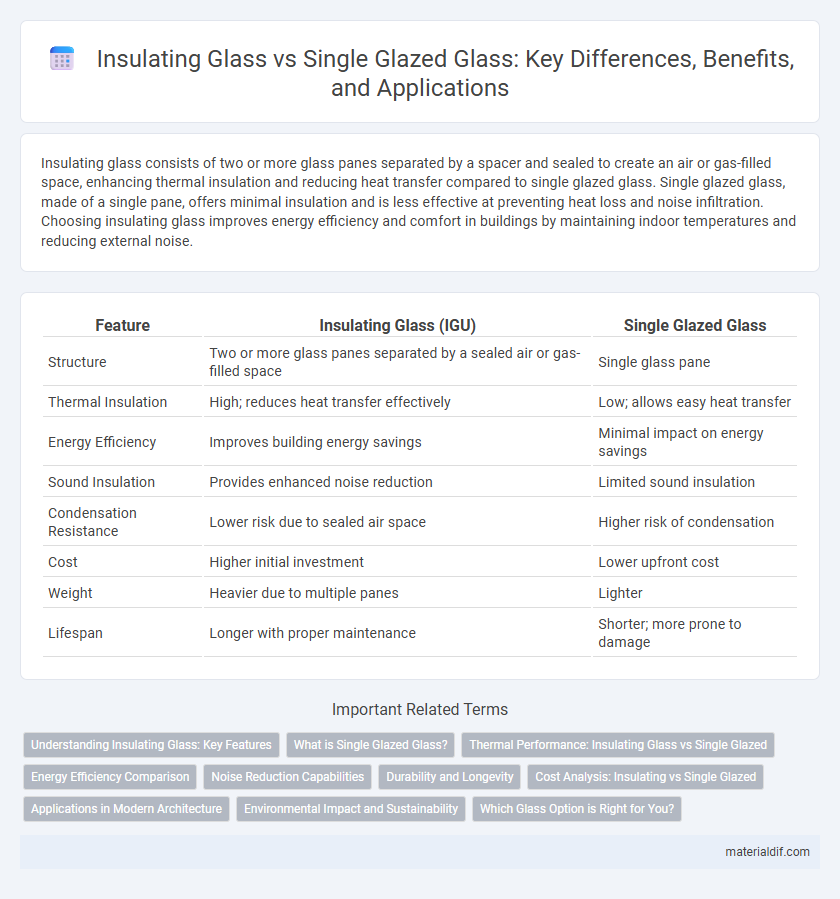Insulating glass consists of two or more glass panes separated by a spacer and sealed to create an air or gas-filled space, enhancing thermal insulation and reducing heat transfer compared to single glazed glass. Single glazed glass, made of a single pane, offers minimal insulation and is less effective at preventing heat loss and noise infiltration. Choosing insulating glass improves energy efficiency and comfort in buildings by maintaining indoor temperatures and reducing external noise.
Table of Comparison
| Feature | Insulating Glass (IGU) | Single Glazed Glass |
|---|---|---|
| Structure | Two or more glass panes separated by a sealed air or gas-filled space | Single glass pane |
| Thermal Insulation | High; reduces heat transfer effectively | Low; allows easy heat transfer |
| Energy Efficiency | Improves building energy savings | Minimal impact on energy savings |
| Sound Insulation | Provides enhanced noise reduction | Limited sound insulation |
| Condensation Resistance | Lower risk due to sealed air space | Higher risk of condensation |
| Cost | Higher initial investment | Lower upfront cost |
| Weight | Heavier due to multiple panes | Lighter |
| Lifespan | Longer with proper maintenance | Shorter; more prone to damage |
Understanding Insulating Glass: Key Features
Insulating glass consists of two or more glass panes separated by a durable spacer and sealed airtight to reduce heat transfer and improve energy efficiency. This design significantly enhances thermal insulation and soundproofing compared to single-glazed windows, which have only one pane of glass. The air or inert gas-filled cavity in insulating glass minimizes temperature fluctuations, making it ideal for reducing heating and cooling costs in residential and commercial buildings.
What is Single Glazed Glass?
Single glazed glass consists of a single layer of glass panel, offering minimal thermal insulation and soundproofing capabilities. This type of glass allows higher heat transfer, resulting in increased energy loss compared to insulating glass units. Single glazing is commonly used in older buildings or interior spaces where insulation is less critical.
Thermal Performance: Insulating Glass vs Single Glazed
Insulating glass significantly enhances thermal performance by reducing heat transfer through its multiple panes separated by an air or gas-filled space, resulting in better insulation compared to single glazed windows. Single glazed glass consists of a single pane that allows higher heat loss and gain, leading to increased energy consumption for heating and cooling. The thermal resistance (R-value) of insulating glass units can be up to three times greater than that of single glazed units, making them more effective in maintaining indoor temperature stability.
Energy Efficiency Comparison
Insulating glass significantly reduces heat transfer compared to single-glazed windows, enhancing energy efficiency by maintaining indoor temperatures and lowering heating and cooling costs. Its multiple panes separated by a gas-filled space act as a thermal barrier, reducing thermal conductivity and preventing heat loss or gain. Single-glazed windows lack this insulation, resulting in higher energy consumption and increased utility bills due to poor temperature regulation.
Noise Reduction Capabilities
Insulating glass significantly improves noise reduction compared to single glazed windows by using multiple glass panes separated by an air or gas-filled space that dampens sound transmission. The dual or triple layers in insulating glass create a barrier that reduces external noise, making it ideal for urban environments or homes near busy roads. Single glazed windows, consisting of a single glass pane, offer minimal sound insulation and allow more noise to penetrate indoor spaces.
Durability and Longevity
Insulating glass, composed of two or more glass panes separated by a gas-filled space, significantly outperforms single glazed glass in durability and longevity due to its resistance to thermal stress and reduced condensation. The multiple layers in insulating glass increase structural integrity, minimizing the risk of cracks and breakage over time compared to the single pane's vulnerability to environmental damage. Enhanced energy efficiency in insulating glass also contributes to its prolonged lifespan, as temperature fluctuations that can weaken single glazed units are effectively mitigated.
Cost Analysis: Insulating vs Single Glazed
Insulating glass typically costs 30-50% more upfront than single glazed windows but offers significant energy savings by reducing heat transfer and improving thermal performance. The higher initial investment in insulating glass is offset over time through lower heating and cooling expenses, potentially saving 15-25% on energy bills annually. Single glazed units, while cheaper initially, often lead to increased energy costs and reduced comfort due to poor insulation properties.
Applications in Modern Architecture
Insulating glass, composed of multiple glass panes separated by a spacer filled with inert gas, offers superior thermal insulation that reduces energy consumption in modern buildings compared to single glazed glass. It is widely used in facades, skylights, and curtain walls to enhance energy efficiency while providing soundproofing and condensation reduction, essential for sustainable architecture. Single glazed glass remains common in interior partitions and decorative features where thermal performance is less critical, balancing cost and design flexibility.
Environmental Impact and Sustainability
Insulating glass significantly reduces energy consumption by providing superior thermal insulation compared to single-glazed windows, leading to lower carbon emissions in heating and cooling. The multilayer construction of insulating glass minimizes heat transfer, enhancing building energy efficiency and reducing reliance on fossil fuels. Additionally, the durability and longer lifespan of insulating glass decrease the frequency of replacements, contributing to less material waste and greater sustainability.
Which Glass Option is Right for You?
Insulating glass, consisting of two or more glass panes separated by a spacer and sealed to create an insulating air space, offers superior thermal performance and energy efficiency compared to single glazed windows with only one pane. Choosing insulating glass reduces heat transfer, minimizes condensation, and lowers energy costs, making it ideal for climates with extreme temperatures. Single glazed glass may be suitable for mild climates or budget-conscious projects where insulation and noise reduction are less critical.
Insulating Glass vs Single Glazed Infographic

 materialdif.com
materialdif.com